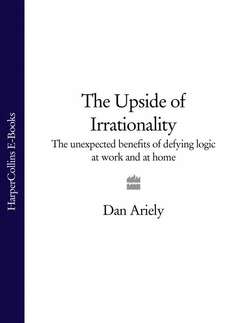Читать книгу The Upside of Irrationality: The Unexpected Benefits of Defying Logic at Work and at Home - Дэн Ариели, Dan Ariely, Dan Ariely - Страница 26
The Division and Meaning of Labor
ОглавлениеI found the consistency between the results of the two experiments, and the substantial impact of such small differences in meaning, rather startling. I was also taken aback by the almost complete lack of enjoyment that the participants in the Sisyphean condition derived from building Legos. As I reflected on the situations facing David, Devra, and others, my thoughts eventually lighted on my administrative assistant.
On paper, Jay had a simple enough job description: he was managing my research accounts, paying participants, ordering research supplies, and arranging my travel schedule. But the information technology that Jay had to use made his job a sort of Sisyphean task. The SAP accounting software he used daily required him to fill in numerous fields on the appropriate electronic forms, sending these e-forms to other people, who filled in a few more fields, who in turn sent the e-forms to someone else, who approved the expenses and subsequently passed them to yet another person, who actually settled the accounts. Not only was poor Jay doing only a small part of a relatively meaningless task, but he never had the satisfaction of seeing this work completed.
Why did the nice people at MIT and SAP design the system this way? Why did they break tasks into so many components, put each person in charge of only small parts, and never show them the overall progress or completion of their tasks? I suspect it all has to do with the ideas of efficiency brought to us by Adam Smith. As Smith argued in 1776 in The Wealth of Nations, division of labor is an incredibly effective way to achieve higher efficiency in the production process. Consider, for example, his observations of a pin factory:
…the division of labour has been very often taken notice of, the trade of the pin-maker; a workman not educated to this business (which the division of labour has rendered a distinct trade), nor acquainted with the use of the machinery employed in it (to the invention of which the same division of labour has probably given occasion), could scarce, perhaps, with his utmost industry, make one pin in a day, and certainly could not make twenty. But in the way in which this business is now carried on, not only the whole work is a peculiar trade, but it is divided into a number of branches, of which the greater part are likewise peculiar trades. One man draws out the wire, another straights it, a third cuts it, a fourth points it, a fifth grinds it at the top for receiving the head; to make the head requires two or three distinct operations; to put it on, is a peculiar business, to whiten the pins is another; it is even a trade by itself to put them into the paper; and the important business of making a pin is, in this manner, divided into about eighteen distinct operations, which, in some manufactories, are all performed by distinct hands, though in others the same man will sometimes perform two or three of them. I have seen a small manufactory of this kind where ten men only were employed, and where some of them consequently performed two or three distinct operations. But though they were very poor, and therefore but indifferently accommodated with the necessary machinery, they could, when they exerted themselves, make among them about twelve pounds of pins in a day. There are in a pound upwards of four thousand pins of a middling size. Those ten persons, therefore, could make among them upwards of forty-eight thousand pins in a day.1
When we take tasks and break them down into smaller parts, we create local efficiencies; each person can become better and better at the small thing he does. (Henry Ford and Frederick Winslow Taylor extended the division-of-labor concept to the assembly line, finding that this approach reduced errors, increased productivity, and made it possible to produce cars and other goods en masse.) But we often don’t realize that the division of labor can also exact a human cost. As early as 1844, Karl Marx—the German philosopher, political economist, sociologist, revolutionary, and father of communism—pointed to the importance of what he called “the alienation of labor.” For Marx, an alienated laborer is separated from his own activities, from the goals of his labor, and from the process of production. This makes work an external activity that does not allow the laborer to find identity or meaning in his work.
I am far from being a Marxist (despite the fact that many people think that all academics are), but I don’t think we should wholly discount Marx’s idea of alienation in terms of its role in the workplace. In fact, I suspect that the idea of alienation was less relevant in Marx’s time, when, even if employees tried hard, it was difficult to find meaning at work. In today’s economy, as we move to jobs that require imagination, creativity, thinking, and round-the-clock engagement, Marx’s emphasis on alienation adds an important ingredient to the labor mix. I also suspect that Adam Smith’s emphasis on the efficiency in the division of labor was more relevant during his time, when the labor in question was based mostly on simple production, and is less relevant in today’s knowledge economy.
